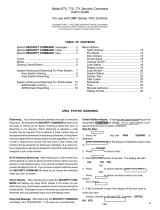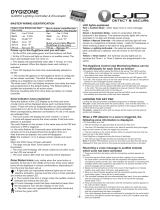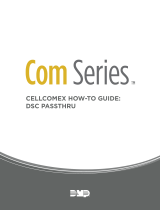
Chapter 4 Programming Descriptions
11
Chapter 4 Programming Descriptions
The following is a brief description of the features and options available in the Power PC1616/1832/1864 control panel. Please refer to the keypad
installation sheet for function key programming.
Global Stay Arming
If enabled by the installer, when this function key is pressed the panel will prompt the user for an access code. The panel will arm all partitions
assigned to that access code in Stay Mode when exit delay expires. If a partition was armed in Away mode when the Global Stay Arming key is
pressed, that partition will switch armed status to Stay when the delay expires. The Force arm attribute must be enabled on Entry/Exit points for
this feature.
Global Away Arming
If enabled by the installer, when this function key is pressed the panel will prompt the user for an access code. The panel will arm all partitions
assigned to that access code in Away Mode when exit delay expires. If a partition was armed in Stay mode when the Global Away Arming key is
pressed, that partition will switch armed status to Away when the delay expires. The Force arm attribute must be enabled on Entry/Exit points for this
feature.
Global Disarming
If enabled by the installer, when this function key is pressed the panel will prompt the user for an access code. The panel will then disarm all par-
titions assigned to that access code.
[001] to [004] Zone Definitions
Option Description
[00] Null Zone: Zone not used
[01] Delay 1: When armed, provides entry delay when violated (follows Entry Delay 1)
[02] Delay 2: When armed, provides entry delay when violated (follows Entry Delay 2)
[03] Instant: When armed, instant alarm when violated
[04] Interior
: When armed, instant alarm will sound first if the zone is violated; instant alarm will follow the entry delay if entry delay is active
[05] Interior Stay/Away: Similar to ‘Interior’ except that panel will auto-bypass the zone if Armed in the Stay mode
[06] Delay Stay/Away: Similar to ‘Delay 1’ except that panel will auto-bypass the zone if Armed in the Stay mode
[07] Delayed 24-Hour Fire (Hardwire): Instant audible alarm when violated, communication is delayed 30 seconds. If alarm is acknowl-
edged during this time (by pressing a key), the alarm will be silenced 90 seconds and will repeat the cycle. If not, alarm will latch and
communicate after a 30-second delay
[08] Standard 24-Hour Fire (Hardwire): Instant alarm and communication when violated
[09] 24-Hr Supervision (Hardwire): Instant alarm and communication when violated. Will not sound the bell or keypad buzzer
[10] 24-Hr Supervisory Buzzer: Instant alarm, panel will activate keypad buzzer instead of bell output
[11] 24-Hr Burglary: Instant alarm when violated, audible alarm at default. Reporting code BA, BH
[12] 24-Hr Hold-up: Instant alarm when violated, silent alarm at default. Reporting code HA, HH
[13] 24-Hr Gas: Instant alarm when violated, audible alarm at default. Reporting code GA, GH
[14] 24-Hr Heat: Instant alarm when violated, audible alarm at default (also known as high-temp). Reporting code KA, KH
[15] 24-Hr Auxiliary (Medical): Instant alarm when violated, silent alarm at default. Reporting code MA, MH
[16] 24-Hr Panic: Instant alarm when violated, audible alarm at default. Reporting code PA, PH
[17] 24-Hr Emergency: Instant alarm when violated, audible alarm at default. Reporting code QA, QH
[18] 24-Hr Sprinkler: Instant alarm when violated, audible alarm at default. Reporting code SA, SH
[19] 24-hr Water: Instant alarm when violated, audible alarm at default (also known as high water level). Reporting code WA, WH
[20] 24-Hour Freeze: Instant alarm when violated, audible alarm at default (also known as low-temp). Reporting code ZA, ZH
[21] 24-Hr Latching Tamper: Instant alarm when violated, panel cannot be armed until Installer Programming is entered
[22] Momentary Keyswitch Arm: Arm or disarm the system when violated
[23] Maintained Keyswitch Arm: Arm system when violated, disarm system when restored
[24] For Future Use
[25] Interior/Delay: Zone will function as an Interior zone when armed in Away mode, and as a Delay zone when armed in Stay mode
[26] 24-Hr Non-Alarm: Zone will NOT create an alarm. Can be used with zone follower function for automation applications
[29] Auto-Verified Fire: When violated, system will reset all smoke detectors for 20 seconds, then wait 10 seconds for detectors to settle.
If another fire alarm is detected within 60 seconds, the zone will go into alarm immediately
























